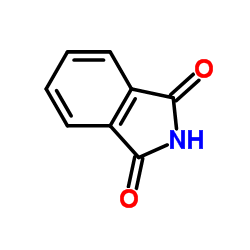O-Phthalimide

O-Phthalimide structure
|
Common Name | O-Phthalimide | ||
|---|---|---|---|---|
| CAS Number | 85-41-6 | Molecular Weight | 147.131 | |
| Density | 1.4±0.1 g/cm3 | Boiling Point | 359.0±25.0 °C at 760 mmHg | |
| Molecular Formula | C8H5NO2 | Melting Point | 232-235 °C(lit.) | |
| MSDS | Chinese USA | Flash Point | 170.9±23.2 °C | |
|
Synthesis and anti-angiogenic activity of benzothiazole, benzimidazole containing phthalimide derivatives.
Bioorg. Med. Chem. Lett. 23(1) , 287-90, (2013) Benzothiazole and benzimidazole containing phthalimide derivatives (NK037, NK041, NK042, NK0139A and NK0148) have been synthesized and their anti-angiogenic activity was evaluated using ex vivo egg yolk angiogenesis model. A comparative study with pure thalid... |
|
|
Phthalimido-ferrocidiphenol cyclodextrin complexes: Characterization and anticancer activity.
Int. J. Pharm. 491 , 323-34, (2015) Several ferrocenyl analogues of tamoxifen have already showed strong antiproliferative activity in experimental glioma models. Nevertheless, these compounds are very poorly soluble in water and an adapted formulation is needed. In this work, we have tailored ... |
|
|
Azolyacetones as precursors to indoles and naphthofurans facilitated by microwave irradiation with simultaneous cooling.
Molecules 14(8) , 2976-84, (2009) Phthalimide reacted with phenacyl bromide under microwave irradiation to yield phenacyl isoindolidene-1,3-dione (3b), while 3a reacted with phenylhydrazine to yield the phenylhydrazone 4 that was readily converted into indoylphthalimide 8. Similarly N-benzotr... |
|
|
A review of methods for the analysis of orphan and difficult pesticides: glyphosate, glufosinate, quaternary ammonium and phenoxy acid herbicides, and dithiocarbamate and phthalimide fungicides.
J. AOAC Int. 97(4) , 965-77, (2014) This article reviews the chromatography/MS methodologies for analysis of pesticide residues of orphan and difficult chemical classes in a variety of sample matrixes including water, urine, blood, and food. The review focuses on pesticide classes that are not ... |
|
|
Bioanalysis and enantioseparation of dl-carnitine in human plasma by the derivatization approach.
Bioanalysis 7 , 2477-88, (2015) L-carnitine is an over the counter drug, used to treat disorders like cardiomyopathy, skeletal myopathy, hypoglycemia and hyperammonemia. Preparations containing D-carnitine should be avoided by dialysis patients because it has toxic influence on biochemical ... |
|
|
Novel anilinophthalimide derivatives as potential probes for beta-amyloid plaque in the brain.
Bioorg. Med. Chem. 18 , 1337-43, (2010) A group of novel 4,5-dianilinophthalimide derivatives has been synthesized in this study for potential use as beta-amyloid (Abeta) plaque probes. Staining of hippocampus tissue sections from Alzheimer's disease (AD) brain with the representative compound 9 in... |
|
|
Synthesis and in vitro cytotoxic evaluation of N-alkylbromo and N-alkylphthalimido-isatins.
Bioorg. Med. Chem. Lett. 21 , 3017-20, (2011) The manuscript pertains to the synthesis and in vitro cytotoxic evaluation of a series of N-alkylbromo and N-alkylphthalimido-isatins against four different human cancer cell lines namely Colon: HCT-15; Liver: Hep-2; Lung: A-549 and Leukemia: THP-1 at 10 and ... |
|
|
Synthesis and in vitro anti Mycobacterium tuberculosis activity of a series of phthalimide derivatives.
Bioorg. Med. Chem. 17 , 3795-9, (2009) New phthalimide derivatives were easily prepared through condensation of phthalic anhydride and selected amines with variable yields (70-90%). All compounds (3a-l) were evaluated against Mycobacterium tuberculosis H(37)Rv using Alamar Blue susceptibility. The... |
|
|
Strong two photon absorption and photophysical properties of symmetrical chromophores with electron accepting edge substituents.
J. Phys. Chem. A 112(21) , 4742-8, (2008) Two photon absorption (TPA) and photophysical properties of three new symmetrical chromophores with electron accepting phthalimide edge substituents have been studied. The three chromophores contain fluorene, alcoxy-substituted divinyl benzene, and carbazole ... |
|
|
Using light to covalently immobilize and pattern nanoparticles onto surfaces.
Langmuir 28(29) , 10934-41, (2012) There is considerable current interest in developing methods to integrate nanoparticles into optical, electronic, and biological systems due to their unique size-dependent properties and controllable shape. We report herein a versatile new approach for covale... |